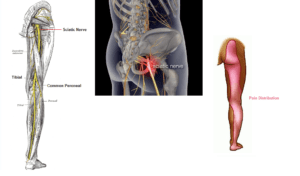
What do football manager Thierry Henry, actress and singer Olivia Newton-John and Jean-Claude Juncker, the former President of the European Commission, all have in common? Not much on the face of it, but the fact is that all three have, at one time or other, been battling sciatica.
The former Arsenal striker went from strength to strength following a bout in 2006. Grease star Newton-John was forced to cancel several concerts two years ago while the painful condition was blamed – amidst much speculation – for the 64-year-old Juncker’s stumbles during a recent Nato summit.
What is sciatica?
The older generation will be more familiar with it as Lumbago, but Sciatica (as it’s now called) is an unpleasant and disruptive condition that can potentially afflict anyone – of all ages and levels of fitness! It’s often confused with other types of back pain and occurs when the sciatic nerve is compressed or injured. This nerve is the largest and longest in the human body. It runs all the way from the lumbar region in the lower back, through the buttocks and down both legs to the feet. Symptoms can make themselves felt anywhere along the nerve, from the lower back, through the genital region and all the way to the feet.
Symptoms of Sciatica
Common symptoms of sciatica include:
- Stabbing, burning or shooting pains along the sciatic nerve in the:
- lower back, hip and/or buttock(s)
- backs of the thighs and down the legs
- feet and/or toes
- genital area
- Burning or tingling (pins and needles) in the legs and/or feet
- Numbness and weakness in affected areas
- All of the above made worse by prolonged sitting, standing or walking, heavy lifting and any activity with an impact on the spine (eg running)
Causes of sciatica
The vast majority of sciatica cases are caused by:
A herniated or protruding disc: Positioned between the vertebrae (bones in the spinal column) discs act as shock absorbers or cushions with the lower spinal discs taking on most of the upper body weight. Over time their hard, fibrous outer structure may develop tiny tears, usually as a result of overload or poor posture. This allows their jelly-like inner core to herniate or protrude, irritating the sciatic nerve. and often referred to as a ‘trapped nerve’.
Poor posture: Sitting incorrectly with more weight on one hip than the other can irritate or compress the sciatic nerve.
Degenerative Spinal Arthritis. Osteoarthritis in the spine can damage the cartilage (connective tissue) on the joints and discs in the neck and lower back, producing spurs of bone that press against the sciatic nerve.
Impingement of the sciatic nerve along its course: the sciatic nerve can be affected by the pelvic joints (sacroiliac joints) or if the nerve passes through the Piriformis muscle (deep in the buttock region), where tightening of the muscle can give sciatic-type symptoms.
Treating sciatica with Robin Kiashek
The condition may improve on its own after four to six weeks, although this largely depends on the patient’s age, medical history, lifestyle and, importantly, whether he or she heeds my advice! Try not to let it interfere with your daily activities. You can help yourself in battling sciatica via:
- Avoiding prolonged sitting
- Keeping moving but only if this doesn’t cause you pain
- Using cold hydrotherapy (sitting in a cool bath or gentle swimming) to relieve pain on the lower spine
- Avoiding high impact activities
- Not sleeping on your front and either putting a pillow under your knees if sleeping on your back, or putting a pillow between your knees if side-lying
Does sciatica go away on its own?
If your symptoms show no sign of improving after a few days, please make an appointment at one of the Robin Kiashek Clinics. I will take a full case history and perform a clinical examination to determine the exact cause of your pain. We will then agree on a treatment plan which may also include advice on exercise, posture, pain management and how to prevent any future attacks.
To get in touch please call 020 8815 0979 or click here.

![sciatica_diagram [Converted]](https://www.robinkiashek.co.uk/wp-content/uploads/2018/12/sciatica_diagram-Converted-251x300.jpg)
 Here at the Robin Kiashek Clinics we promote prevention, and have plenty of advice on keeping your spine healthy and pain-free (
Here at the Robin Kiashek Clinics we promote prevention, and have plenty of advice on keeping your spine healthy and pain-free (